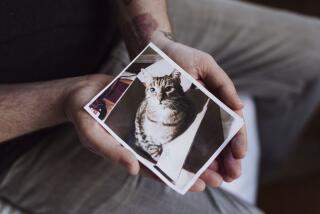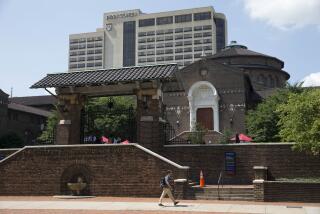Mummy going, going, gone on eBay? Not quite
BALTIMORE — Ronn Wade wants his mummy back.
It’s a quest that started in October, when Michigan authorities confiscated the mummified cadaver of a child illegally placed for sale on eBay.
The incident briefly made headlines around the world. And Wade, director of the anatomical services division at the University of Maryland School of Medicine, is convinced the body is part of an obscure but historic set of medical mummies known as the Burns collection.
Acquired by the university in 1820, it’s one of the oldest collections of mummies once used for dissection that is in the United States. Since 1974, Wade has been its de facto curator.
“They’re such an interesting part of the history of anatomy -- definitely one of a kind,” says Kristin Horner, a Michigan State University anthropologist who helped produce a recent National Geographic TV program on the Burns mummies.
Preserved in a toxic stew of arsenic and salt, the artfully dissected specimens helped educate the first generation of medical students at the University of Maryland, which celebrates its bicentennial next year.
The mummies also are revealing relics of the trade’s murky early days, when the dissection of human corpses was banned and desperate medical students routinely turned to body snatching to practice their craft.
“Few sciences are as rooted in shame, infamy and bad PR as human anatomy,” writes Mary Roach in “Stiff: The Curious Lives of Human Cadavers.”
For all these reasons, Wade wants his mummy back. There’s just one problem: The Detroit man who put the specimen up for sale may not want to hand it over.
“I’m not going to fight over dead people,” says Wade, who oversees the state’s donor body program. “It’s a question of ethics. It all ties into the history of medicine in Maryland.”
All bodies donated to science in the state wind up at the Bressler Research Building in Baltimore, says Wade, who also serves as director of the State Anatomy Board. Much of the Burns collection is there too.
Wade stores the 200-year-old Burns cadavers in half a dozen cartons alongside newer arrivals, respectfully hidden on draped gurneys or bagged in plastic and stacked along the walls.
Wade pulled out a Burns specimen he keeps in his office credenza to show visitors. It’s the left half of a shriveled head, masterfully dissected to reveal the carotid artery. The head, which Wade stores in a No. 10 envelope box, is the color of beef jerky and smells of age.
“I wouldn’t get too close,” Wade warned when a visitor started to bend near. Chemical analysis, he said, had revealed the cadavers contain mercury, arsenic, lead, sugar and salt.
From a red plastic bag, he pulled out another Burns collection showpiece: a mummified arm with a crude black-and-red tattoo.
“It’s the only identifying mark on any of the specimens,” Wade said. The tattoo depicts the coat of arms of Pope Pius VII, who served between 1800 and 1823.
Wade called it a tantalizing clue to a major mystery: Who were these people?
All Wade knows is that the collection was created by Scottish anatomist Allen Burns in the early 1800s. Burns lacked a formal education, but his knowledge of anatomy and skill with a knife were legendary.
At 16, he was already running the dissection room of a prominent Glasgow medical school. By 30, he had penned two of the field’s early classic texts and identified several anatomical structures -- the space of Burns, Burns’ ligament -- that still bear his name.
But Burns, according to Wade, was equally famous for his hard-won collection of dissected cadavers, known then as the Burns Museum.
At that time, the only legal source of cadavers was the public executioner. When dead criminals were in short supply, anatomists had little choice but to rob graves -- or pay professional “resurrectionists” to obtain bodies on their behalf.
Burns himself was a convicted body snatcher.
Before his death in 1813, Burns bequeathed his collection to a protege named Granville Patterson, who was later hired by the University of Maryland as its chairman of surgery. In 1820, Patterson sold the Burns Museum to the school for $7,800 -- more than $134,000 in today’s dollars.
Once numbering more than 500 specimens, the collection today comprises fewer than 150 dissected adult body parts and a few precious intact infants.
The rest, Wade says, were probably lost, tossed or stolen.
Burns’ mummies do turn up from time to time. In the early 1990s, Wade got a call from a man in southern Maryland who literally had a skeleton in the closet.
The skeleton -- of a small child -- was found with the belongings of the man’s great-great-great-uncle, a physician who had studied at the university in the late 1800s. Wade drove down to fetch it.
Then, a few months ago, Wade received another call. This time it was from Horner at Michigan State University.
Horner, who is getting her Ph.D. in anthropology, had seen the Burns collection up close in 2003 while helping the crew of the National Geographic Channel’s “Mummy Road Show” shoot a program on it.
Horner recalled being awestruck: “This is really incredible stuff.”
Burns, she says, was especially interested in the human cardiovascular system.
Many of his specimens have exquisitely prepared blood vessels.
“These are some difficult dissections,” said Horner, who plans to return to Maryland to conduct the first scientific study of the collection.
By coincidence, Horner’s Ph.D. advisor at Michigan State, a forensic anthropologist named Norman Saunders, had been asked to examine the confiscated eBay mummy.
At the time, police had no idea whose body it was or whether it was part of a crime.
“It’s a remarkable specimen,” said Saunders, who estimated the child is between 7 and 9 years old.
“It’s just beautifully, artistically dissected. I never dreamed that it was 200 years old,” he said.
But when Saunders showed it to his student, Horner recognized it as part of the University of Maryland collection and phoned Wade at the medical school.
Michigan authorities, meanwhile, had traced the skeleton to a Detroit-area renovator and antiques collector, Terry Fadina.
Fadina told police he had discovered the mummy in the basement of an old Detroit school sometime in the 1980s. The building was about to be torn down and Fadina had bought salvage rights.
By the time eBay pulled the plug on the auction, bidding on the mummy had soared to $500. (The high bid was from a buyer named “Satan’s Child.”)
Det. Duane Loxton of the Port Huron Police Department, which originally recovered the mummy, said police were unsure at first how to proceed.
“We don’t have these every day,” he said.
After interviewing Fadina, police determined that no crime had been committed.
But Loxton said that still left one big question: “Who is the rightful owner of this?”
“It might make an interesting exam question,” said Henry T. “Hank” Greely, director of the Center for Law and the Biosciences at Stanford University.
He and other property law experts said they weren’t entirely clear how the case should be resolved.
At the request of local authorities, Michigan State’s Saunders will prepare a report to document any similarities between the eBay cadaver and the Burns collection specimens.
One early clue that the mummy has Maryland roots: signs of sugar curing, just like the Burns mummies.
Meanwhile, the Detroit salvager who found the object has told police that he may not want to hand it over.
“Remember, it had been for sale,” Fadina said.
Wade and other medical school officials said they didn’t have any records to prove the eBay mummy was once part of the Burns collection.
“The problem is, even if it’s similar to the Maryland mummies, there’s no way of knowing how it left Maryland,” said William Pearlstein, a New York City attorney specializing in art and antiquities law.
Officials at the medical school said they hoped the Detroit man ultimately recognized the mummy’s home was here.
“It is very valuable and very historic,” said Larry Pitrof of the school’s Medical Alumni Assn., which has been paying for the collection’s upkeep and hopes to put the entire collection on display in the coming years.
Besides, said Pitrof, “My big question would be: What’s he going to do with it?”
More to Read
Sign up for Essential California
The most important California stories and recommendations in your inbox every morning.
You may occasionally receive promotional content from the Los Angeles Times.










